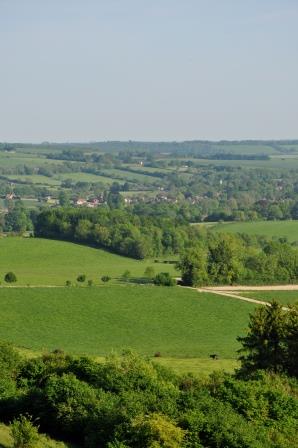Research
Landscape-scale conservation
Farmers’ opinions and priorities are vital to understanding the possibilities for farming and wildlife, for identifying key questions, and refining approaches to answering them. An early survey in the 1980s, a pivotal time of change in lowland farming, and views and priorities that farmers expressed shaped the WildCRU’s approach to research in agro-ecology, and led ultimately to an emphasis on landscape-scale approaches. There were two such projects, one based in the Chichester Plain, and the second in the Upper Thames tributaries. Both illustrate the importance of a collaborative partnership approach, integrating the efforts of researchers, non-government and government stakeholders, and engaging many farmers (325 landowners in the case of the Upper Thames project). We reported on targeted delivery of habitat improvements, drawing on case studies of water voles and moths, together with illustrations of the importance of landscape connectivity, for hedgehogs and toads. These projects illustrate the importance of farmers and researchers working together to find solutions at a landscape scale.
Philip Riordan
Ruth E. Feber
Eva M. Raebel
Paul J. Johnson
David W. Macdonald
References
Salazar RD, Montgomery RA, Thresher SE, Macdonald DW (2016) Mapping the Relative Probability of Common Toad Occurrence in Terrestrial Lowland Farm Habitat in the United Kingdom. PLoSONE 11(2): e0148269. doi:10.1371/journal.pone.0148269
Riordan, P., Feber, R.E., Raebel, E.M., Johnson, P.J., Macdonald, D.W. 2015. From science to practice: delivering conservation across the landscape. In: Wildlife Conservation on Farmland. Eds: D.W. Macdonald & R.E. Feber. Oxford University Press.
Moorhouse, T. P., Palmer, S. C. F., Travis, J.M. J., et al. (2014) Hugging the hedges: Might agri-environment manipulations affect landscape permeability for hedgehogs? Biological Conservation, 176, 109-116.
Slade, E.M., Merckx, T., Riutta, T., Bebber, D.P., Redhead, D., Riordan, P., and& Macdonald, D.W. (2013). Life-history traits and landscape characteristics predict macro-moth responses to forest fragmentation. Ecology, 94, 1519–1530.
Merckx, T., Marini, L. Feber, R.E., Macdonald, D.W. (2012). Hedgerow trees and extended-width field margins enhance macro-moth diversity: implications for management. Journal of Applied Ecology, 49, 1396–1404.
Merckx, T., Feber, R.E., Riordan, P., et al. (2009). Optimizing the biodiversity gain from agri-environment schemes. Agriculture, Ecosystems and Environment, 130, 177–182.
Dutton, A., Edwards-Jones, G., Strachan, R., & Macdonald, D. W. (2008). Ecological and social challenges to biodiversity conservation on farmland: reconnecting habitats on a landscape scale. Mammal Review, 38, 205–219.
Feber, R.E., Asteraki, E.J., Firbank, L.G. (2007) Can farming and wildlife coexist? In: Key Topics in Conservation Biology (Ed. by D.W. Macdonald & K. Service, eds. ), Key Topics in Conservation Biology, pp. 239–252. Blackwell Publishing, Oxford, UK.
Gelling, M., Macdonald, D. W., Mathews, F. (2007). Are hedgerows the route to increased farmland small mammal density? Use of hedgerows in British pastoral habitats. Landscape Ecology, 22, 1019–1032.
Macdonald, D.W., Tattersall, F.H., Service, K.M., Firbank, L.G., Feber, R.E. (2007). Mammals, agrienvironment schemes and set-aside—what are the putative benefits? Mammal Review, 37(4), 259–277.
Strachan, R. and Holmes-Ling, P. (2003). Restoring water voles and other biodiversity to the wider countryside. A report on the Chichester Coastal plain sustainable farming partnership. Wildlife Conservation Research Unit, Oxford.
Ward, J.F., Austin, R.M., and Macdonald, D.W. (2000). A simulation model of foraging behaviour and the effect of predation risk. Journal of Animal Ecology, 69, 16–30.
Macdonald, D.W. and Johnson, P.J. (2000). Farmers and the custody of the countryside: Trends in loss and conservation of non-productive habitats. Biological Conservation, 94, 221–234.
Macdonald, D.W., Johnson, P.J., Feber, R.E. and Tattersall, F.H. (2000). Habitat heterogeneity on farmland. In M. Hutchings., eds. Ecological Consequences of Habitat Heterogeneity, pp. 357–378. Blackwell Science, Oxford.
Ward, J.F., Macdonald, D.W., and Doncaster, C.P. (1997). Responses of foraging hedgehogs to badger odour. Animal Behaviour, 53, 709–720.
Ward, J.F., Macdonald, D.W., Doncaster, C.P., and Mauget, C. (1996). Physiological response of the European hedgehog to predator and nonpredator odour. Physiology and Behavior, 60, 1469–1472.
Macdonald, D. W., Johnson, P. J. (1995). The relationship between bird distribution and the botanical and structural characteristics of hedges. Journal of Applied Ecology, 32, 492–505.
Strachan, R. and Jefferies, D.J. (1993). The water vole Arvicola terrestris in Britain 1989–1990: its distribution and changing status. The Vincent Wildlife Trust, London.
Macdonald, D.W. (1984). A questionnaire survey of farmers’ opinions and actions towards wildlife on farmlands. In D. Jenkins, ed. ITE Symposium No. 13: Agriculture and the environment, pp. 171–177. Access Year.
-
 © Ruth Feber
© Ruth Feber





